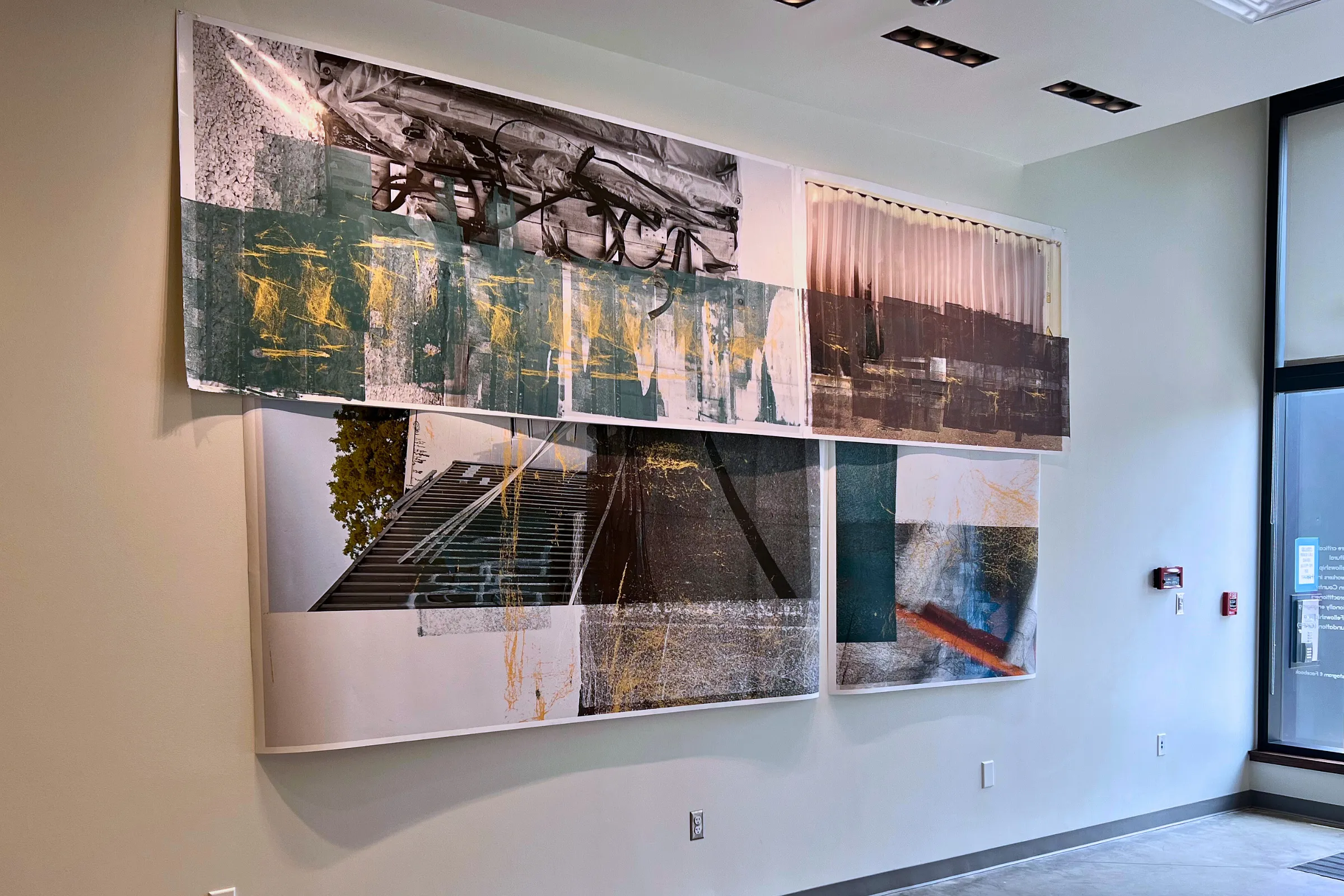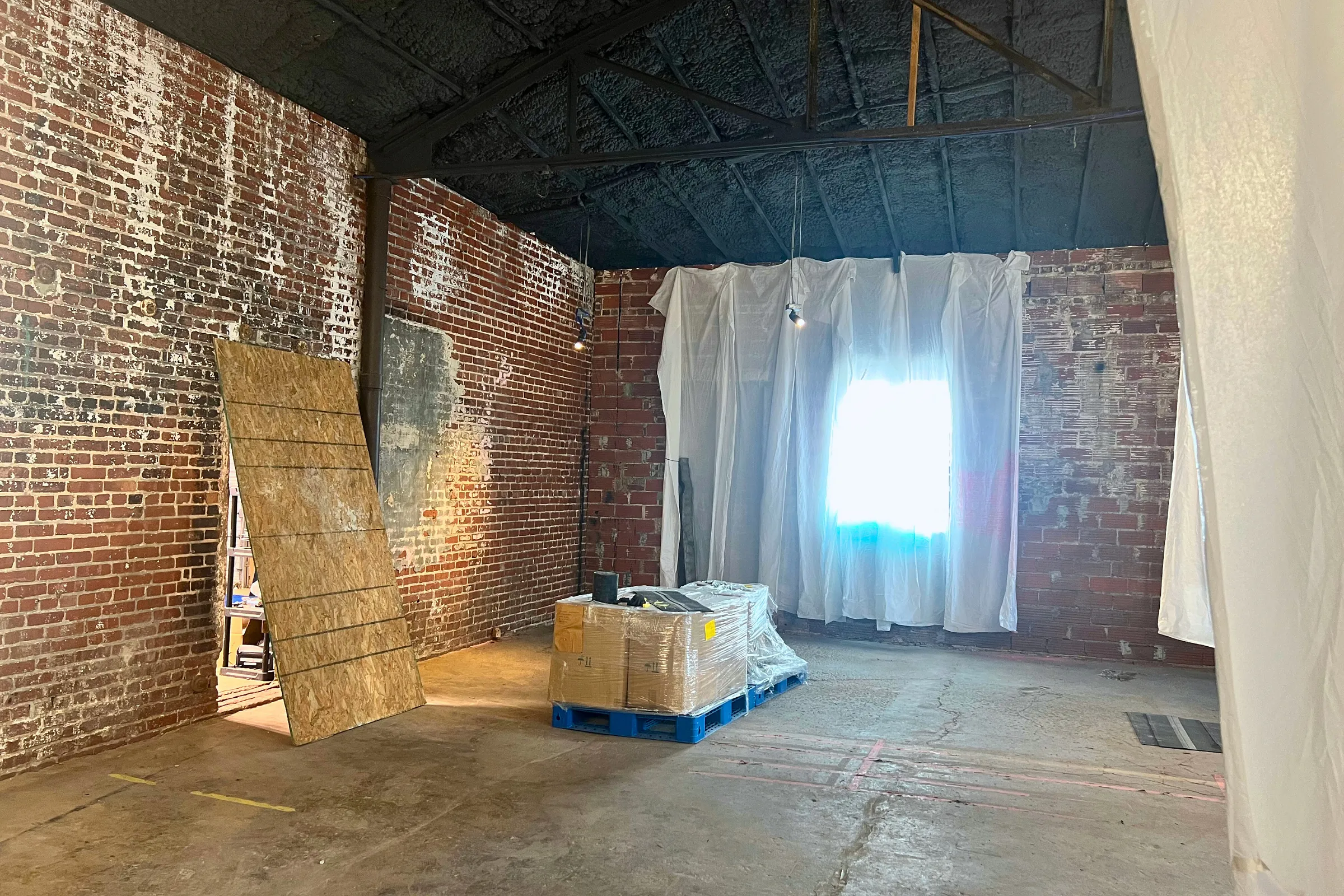Maple St. Construct: “Home On The Range“
1303 E Admiral Blvd.
Tulsa
June 14, 2024
Throughout history, we see humans’ imprint on natural and manmade environments through careful, slight and intentional acts of cultivating space and light. Take Fajada Butte in Chaco Culture National Historical Park, New Mexico, as one example of the marking, carving and sculpting of space intended for a celestial-divine-human experience. Over ten centuries later, consider Gordon Matta Clark’s Splitting, a film that documents an architectural performance in 1974 in which the artist bisected a New Jersey home with a chainsaw, resulting in a slice of light created by the subtractive process that recalls the “sun dagger” in Chaco Canyon. The mid-century Austrian-born American artist and architect R. M. Schindler worked against the use of “construction” and “ornament” in architecture, instead centering his practice on the use and control of space, climate, light and mood.
A recent exhibition by Maple St. Construct and Gabriel Delponte, installed in an industrial space just east of downtown Tulsa, took viewers into this mode of architectural thought and practice. To get to Home on the Range, one had to carefully pass one’s body through a doorway partially covered by a plywood board. Once in the space, at 1303 E. Admiral Blvd. — a warehouse owned by T‑Town Roofing — viewers were met with sculptural forms made of found materials: roofing shingles laid on the ground, stacks of bricks, wooden pallets, drop cloth, steel bars. Draped over the bowstring trusses of the warehouse hung unframed large-format photographic prints that the members of Maple St. Construct took at the warehouse and its surrounding campus.
The prints referenced the very space in which viewers experienced them. A la Schindler, they reinforced the abandonment of construction and ornament as a way to practice art and architecture and instead focused one’s awareness on the details of the space. What was created by the artists, and what was arranged? What was already in the space, and what was added? Light pink chalk marks on the brick wall mimicked the chipped and worn paint. Pallets of materials were dressed in drop cloth. Rope traveled the walls. Strips of metal were laid on the floor or balanced over wooden arms. Ultimately, the use and control of light, space and material defined the warehouse-slash-gallery and marked the site as an experience rather than a hot storage facility.

Maple St. Construct defines itself as a collective of artists and architects located between the West Coast and the Midwest. The collective is many things: a storefront gallery in Omaha, Nebraska, a studio and residency in the Omaha neighborhood known as Little Italy, and what its website describes as “a voice in Los Angeles.” They create and curate exhibitions and produce a yearly catalog of their projects and collaborations. As collective member Mike Nesbit stated, “Maple St. Construct seems to be built around this collage of looseness, as if you could just take away one nail, remove one thread and it will all fall apart.”
Out for a jog while at a residency at Omaha’s Bemis Center for Contemporary Arts in 2021, artist Shane Darwent (an alum of the Tulsa Artist Fellowship and creator of Plains Exchange) happened upon the nearby Little Italy home and studio of Maple St. Construct’s Thomas Prinz. A series of connections brought Darwent into the collective’s fold, resulting in an exhibition at the storefront gallery by him and Daniel Paul Schubert in 2021. This past spring, the Little Italy site housed Darwent and his wife, Elspeth Schulze (also a Tulsa Artist Fellowship alum), and their son Isa, while they were in Omaha for a week-long residency at Maple St. Construct, where they produced a series of works for an exhibition titled Matter Shifting Space.
The relationship built between the collective, Darwent, and Schulze resulted in a recent two-week residency in Tulsa, which welcomed three of the members of Maple St. Construct: Nesbit, Prinz, and Robin Donaldson. Arriving in Tulsa with only their large format printer, these artists and architects responded to the roofing warehouse and the available materials as fodder for Home on the Range on E. Admiral Blvd. and a concurrent exhibition at the Archer Studios at Tulsa Artist Fellowship. United by their shared education at Southern California Institute of Architecture and true to their Maple St. Construct approach, the artists collaborated with Tulsa-based artist Gabriel Delponte, who also served as the connection to T‑Town; with Seejon Thomas, a Los Angeles-based filmmaker who created a documentary of their time in Tulsa; and with Flash Flood Print Studios, where some of the works on view in both spaces were created.

Besides the beauty of the works and the experience of delight I felt as I walked through the space on E. Admiral, their self-referential nature was most noticeable. I love this kind of work, the type that makes you remember that each act and space we create can and should be considered in a way that makes our lives more beautiful. It dilutes the boundary between art and life and brings the viewer into the process of making through observation. This is what architecture has the potential to do: it asks the inhabitant to live in the space, alter it, add to it over time and notice the way light moves and changes in the space. It is a living thing begging to be occupied.
The large-format photographs in Home on the Range were images of what was around us, recordings of where we were immediately located; the materials used were indigenous to the site; there was no concealing of location; and the imperfections were elevated by the way the artists curated the space, giving special attention to the light. (That’s something Darwent himself explores in his forthcoming installation at the Tulsa International Airport.) Tulsa gets lots of sunshine, more so than the national average. The quality of light in the Admiral space and recorded in the photographic prints remind us of where we are — and the surrounding potential that exists in this place.
Next at Tulsa Artist Fellowship: 𐓏𐒰𐒿𐒷́𐓒𐒷 (Markings), opening at the Flagship June 25







